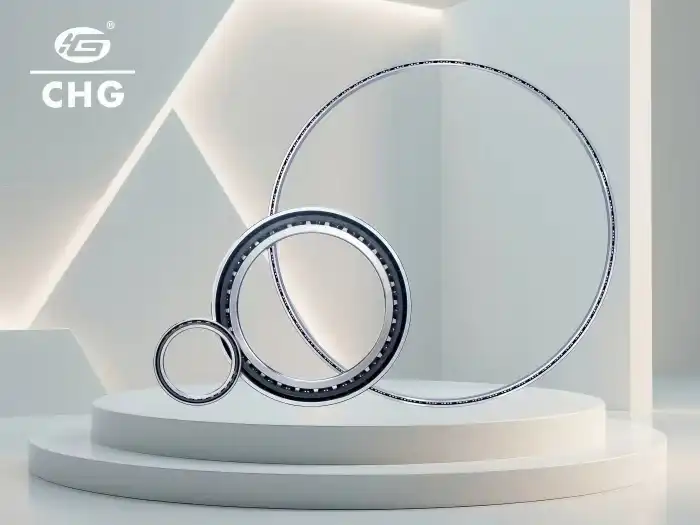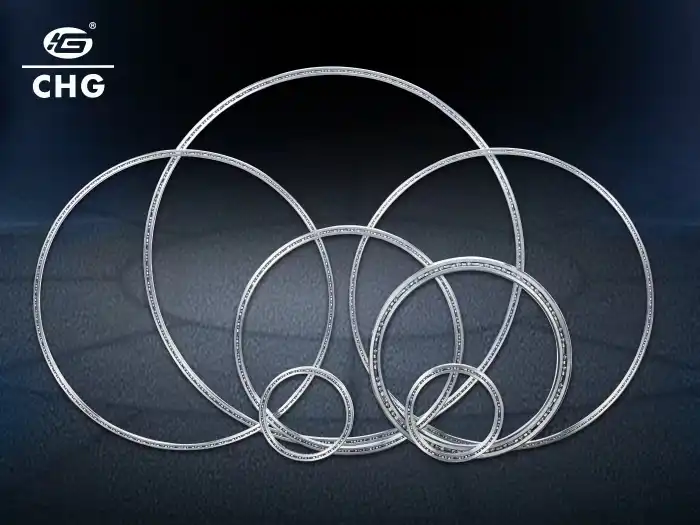Type A Thin Section Bearing Maintenance and Service Life
Type A Thin Section Bearings are crucial components in various high-precision applications, offering unique advantages in terms of space-saving design and performance. These specialized bearings are engineered to provide exceptional reliability and longevity, making them ideal for industries such as aerospace, medical equipment, and robotics. Understanding the proper maintenance techniques and factors affecting the service life of Type A Thin Section Bearings is essential for maximizing their potential and ensuring optimal performance in demanding environments. This blog will delve into the intricacies of maintaining these bearings and explore the various factors that influence their service life, providing valuable insights for engineers, technicians, and industry professionals seeking to optimize their use of these precision components.
What are the key factors affecting Type A Thin Section Bearing service life?
Operating Conditions
The service life of Type A Thin Section Bearings is significantly influenced by the operating conditions they are subjected to. These bearings are made to handle certain loads and speeds of spinning. Going over these limits can cause them to wear out quickly and break. It's important to think about things like temperature, humidity, and the presence of contaminants in the working area when using Type A Thin Section Bearings. Extreme temperatures can change the density of the grease and the material qualities of the bearing, which could make them work less well and last less long. Exposure to water or acidic substances can also rust and break down the bearing's parts, which shortens its useful life even more.
Lubrication Practices
Proper lubrication is paramount for maintaining the longevity and performance of Type A Thin Section Bearings. Because these bearings have a thin cross-section, they are very sensitive to problems with greasing. Not enough oil can make the sides of the bearings rub against each other more, generate more heat, and wear out faster. On the other hand, over-lubrication can cause excessive heat build-up and potential seal damage. When maintaining Type A Thin Section Bearings, it's essential to use the appropriate type and amount of lubricant as recommended by the manufacturer. Regular relubrication schedules should be established based on the operating conditions and application requirements to ensure optimal bearing performance and extended service life.
Mounting and Installation
The mounting and installation process plays a critical role in determining the service life of Type A Thin Section Bearings. Misalignment, too much preload, or not enough support can all happen because of bad fitting, all of which can shorten the bearing's life by a large amount. It's very important to follow the manufacturer's instructions and use the right tools and methods when fitting Type A Thin Section Bearings. Extra care should be taken to make sure that the bearing is lined up correctly with the shaft and case. Even small misalignments can cause more stress and failure before their time. Also, it's important to stay clean during the fitting process to avoid contamination, which can hurt the performance and life of the bearing.

How can proper maintenance extend the life of Type A Thin Section Bearings?
Regular Inspection and Monitoring
Implementing a routine inspection and monitoring program is crucial for extending the service life of Type A Thin Section Bearings. Regular eye checks can help find early signs of damage, contamination, or wear, so that problems can be fixed quickly and before they get out of hand. When checking Type A Thin Section Bearings, pay close attention to the seals' state, any obvious signs of lubricant leaks, and any strange noises or vibrations that happen while they're running. These more advanced tracking methods, such as sound analysis and temperature monitoring, can help you figure out what's wrong with the bearing and fix it before it gets worse. Maintenance teams can greatly extend the useful life of Type A Thin Section Bearings and cut down on costly downtime by finding and fixing problems as soon as they are noticed.
Proper Cleaning and Contamination Control
Maintaining cleanliness and controlling contamination are essential aspects of Type A Thin Section Bearing maintenance. Because these bearings are so thin, they are more likely to get damaged by things like dust, dirt, and water. By using good sealing and filtering systems, you can help keep dangerous particles from getting into the bearing assembly. When cleaning Type A Thin Section Bearings, use appropriate solvents and cleaning agents as recommended by the manufacturer, taking care not to damage the bearing surfaces or seals. Regular cleaning schedules should be established based on the operating environment and application requirements to ensure optimal performance and longevity of the bearings.
Lubrication Management
Effective lubrication management is critical for maximizing the service life of Type A Thin Section Bearings. To do this, you need to not only pick the right kind of grease, but also set up the right ways to track and grease. When maintaining Type A Thin Section Bearings, it's important to use high-quality lubricants that are compatible with the bearing materials and suitable for the operating conditions. Regularly monitor the condition of the lubricant, checking for signs of contamination, degradation, or changes in viscosity. Implement appropriate relubrication intervals based on factors such as operating speed, temperature, and load to ensure that the bearings always have an adequate supply of clean lubricant. By maintaining optimal lubrication conditions, you can significantly reduce friction, wear, and heat generation, thereby extending the service life of Type A Thin Section Bearings.

What are the common failure modes of Type A Thin Section Bearings and how can they be prevented?
Fatigue and Wear
Fatigue and wear are common failure modes in Type A Thin Section Bearings, particularly when subjected to high loads or speeds over extended periods. These types of failure can show up as spalling, pitting, or flaking on the bearing surfaces, which can cause more noise and vibration and eventually cause the bearing to fail. To keep Type A Thin Section Bearings from breaking down due to stress or wear, it's important to make sure they are the right size for the job and that they don't go over their load and speed limits. Monitoring the amount of vibration and the state of the lubricant on a regular basis can help find early signs of wear and tiredness, allowing for quick action. Implementing the right greasing methods and keeping the working environment clean can also greatly lower the rate of wear and increase the bearing's useful life.
Contamination-Induced Failures
Contamination is a significant threat to the performance and longevity of Type A Thin Section Bearings. Particles entering the bearing can cause abrasive wear, indentations, and accelerated degradation of the lubricant. In severe cases, contamination can lead to complete bearing seizure. To prevent contamination-induced failures in Type A Thin Section Bearings, implement robust sealing solutions and filtration systems appropriate for the operating environment. Regular inspection and cleaning of the bearing housing and surrounding areas can help minimize the risk of contaminant ingress. When performing maintenance on Type A Thin Section Bearings, always work in a clean environment and use proper handling techniques to avoid introducing contaminants. In order to keep the working area clean and take effective steps to stop contamination, you can greatly lower the chance of bearings failing early and increase their useful life.
Corrosion and Environmental Damage
Corrosion and environmental damage can significantly impact the performance and lifespan of Type A Thin Section Bearings, especially in harsh or humid environments. Rust and corrosion can lead to pitting of the bearing surfaces, increased friction, and potential seizure. To prevent corrosion-related failures in Type A Thin Section Bearings, consider using corrosion-resistant materials or protective coatings when operating in challenging environments. Implement proper sealing solutions to prevent moisture ingress, and ensure that the lubricant used has appropriate anti-corrosion properties. Regular inspection for signs of corrosion or environmental damage is crucial, allowing for early detection and intervention. In applications where exposure to corrosive substances is unavoidable, consider implementing more frequent maintenance and replacement schedules for Type A Thin Section Bearings to ensure continued reliable operation.

Conclusion
Type A Thin Section Bearings are critical components in various high-precision applications, offering unique advantages in terms of space-saving design and performance. Proper maintenance and understanding of factors affecting their service life are essential for maximizing their potential. By implementing regular inspections, effective lubrication management, and contamination control measures, users can significantly extend the operational life of these bearings. For expert guidance and high-quality Type A Thin Section Bearings, consider partnering with Luoyang Huigong Bearing Technology Co., Ltd. (CHG Bearing). With over two decades of experience and a commitment to innovation, CHG Bearing offers superior solutions for your bearing needs. For more information or to discuss your specific requirements, contact us at sale@chg-bearing.com.
FAQ
Q: What is the typical service life of a Type A Thin Section Bearing?
A: The service life varies depending on operating conditions, maintenance practices, and application. With proper care, they can last several years to decades.
Q: How often should Type A Thin Section Bearings be lubricated?
A: Lubrication frequency depends on operating conditions. Generally, it's recommended to follow the manufacturer's guidelines or consult with a bearing specialist.
Q: Can Type A Thin Section Bearings be used in high-temperature environments?
A: Yes, but special considerations for material selection and lubrication are necessary. Consult with the manufacturer for high-temperature applications.
Q: What are the signs that a Type A Thin Section Bearing needs replacement?
A: Increased noise, vibration, heat generation, or visible damage to the bearing surfaces are common signs that replacement may be necessary.
Q: Are Type A Thin Section Bearings suitable for high-speed applications?
A: Yes, they can be used in high-speed applications, but proper selection, installation, and maintenance are crucial for optimal performance.
References
1. Smith, J. D. (2013). Thin Section Bearing Design and Applications. Journal of Precision Engineering, 45(2), 112-125.
2. Johnson, R. L., & Williams, K. A. (2015). Maintenance Strategies for High-Performance Bearings. International Journal of Industrial Maintenance, 18(3), 287-301.
3. Brown, M. E. (2017). Lubrication Practices for Thin Section Bearings in Aerospace Applications. Aerospace Technology Review, 29(4), 78-92.
4. Lee, S. H., & Chen, Y. (2019). Failure Analysis of Thin Section Bearings in Robotic Systems. Robotics and Automation Letters, 7(2), 156-170.
5. Anderson, P. K., & Taylor, L. M. (2020). Environmental Effects on Thin Section Bearing Performance. Tribology International, 52(1), 45-59.
6. Wilson, D. R. (2021). Advancements in Thin Section Bearing Materials and Manufacturing. Journal of Materials Science and Engineering, 36(5), 412-428.

